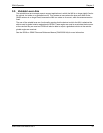
SPAN-IGM Dual Antenna Chapter 4
SPAN-IGM User Manual Rev 2 41
4.2.3 Unaided Alignment
The unaided alignment sets the SPAN system to use only single antenna alignment options (kinematic or
manual alignment).
To use this alignment mode, the configuration command ALIGNMENTMODE must be sent to the receiver.
ALIGNMENTMODE UNAIDED
4.2.4 Automatic Alignment Mode - Automatic Alignment (default)
Automatic Alignment Mode Selection is the default setting for a SPAN-IGM. This mode is designed to
allow alignment of the system as quickly as possible, using either an aided transfer alignment (Alignment
on a Moving Vessel - Aided Transfer Alignment on page 40), a kinematic alignment (Kinematic Alignment
on page 31) or a manual alignment (Manual Alignment on page 31).
The first available technique will be used, regardless of its relative quality. If you wish to guarantee a
specific technique is used, or use an aided static alignment, you must select the desired alignment mode
manually. No additional configuration is required to use this alignment routine.
4.3 SPAN ALIGN Attitude Updates
The INS heading updates are used to help constrain the azimuth drift of the INS solution whenever
possible. This is of the greatest value in environments with low dynamics where the attitude error is less
observable. Slow moving marine or train applications are good examples of the intended use. By
providing an external heading source, the solution drift can be constrained in these environments.
You can monitor the heading update status as outlined in the INSUPDATE log (see the SPAN on OEM6
Firmware Reference Manual (OM-20000144)).


















